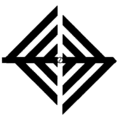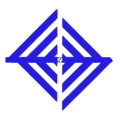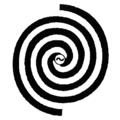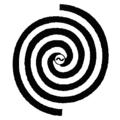Self-complementary antenna
| Part of a series on |
| Antennas |
|---|
 |
|
Common types |
|
Radiation sources / regions |
The self-complementary antenna (SCA) is a basic antenna for extremely broadband practical antennas.[1][2][3][4] This antenna[5][6] is an arbitrarily shaped antenna which is constituted with a half of an infinitely extended planar-sheet conductor such that the shape of its complementary structure is exactly identical, or "self-complementary"[7] with that of the original structure with two terminals for the simplest case. The self-complementary antenna has constant input impedance[8][9] independent of the source frequency and the shape of the structure.
The type of the self-complementary antenna is not limited only to the case of a planar antenna with two terminals, but there are more general types[10] of structures with various grades of complexity and infinite freedom in their structures, such as, the number of terminals, the number of reference planes, and others.[11] They also have constant-impedance property independent of the source frequency and the shape of the structure for respective classes of structures with various grades of complexity. This general principle of self-complementarity is also called the "Mushiake Principle" by various sources.
Examples for two shapes of the structures are shown in the attached figures. The structures 1 to 3 are for square shape,[12] and the structures 4 to 6 are spiral shape. Actually, the structures extend infinitely, but the figures show only finite portions near the feed point of each structure.
-

Explanation of SCA structure 1
-

Explanation of SCA structure.2
-

Explanation of SCA structure.3
-

Explanation of SCA structure.4
-

Explanation of SCA structure.5
-

Explanation of SCA structure.6
The equation which gives the constant value of the input impedance for self-complementary antenna is called the "Mushiake Relationship". The values of the constant-impedance for various classes of complexity in the self-complementary structures depend on the respective grades of the complexity. For example, the Mushiake relationship for the simplest self-complementary planar antenna with two terminals is expressed as:
Z = Z0/2≒188.4 [Ω], (Mushiake relationship)
where Z is the input impedance of the antenna, and Z0 is the intrinsic impedance of the medium.
Moreover, experimental studies on self-complementary antennas, including radiation properties, are conducted in Japan. As the results of the experiment, it is found that the truncated alternate-leaves type self-complementary antenna (or Square SCA) has practically omnidirectional radiation pattern[13] as well as the broadband property.
Comparison with log-periodic antennas
The log-periodic antenna is a modified, folded up, square self-complementary antenna with log-periodic shape, and the original structure before its modification has a typical self-complementary shape. The log-periodic shape does not provide the broadband property for antennas.[14] This fact is experimentally proven.[15] It is also evident from the IEEE definition of “Log-Periodic Antenna”.[16] The "Log-Periodic Dipole Array"[1] or "Log-Periodic Dipole Antenna"[17] (LPDA), is a practically modified self-complementary antenna. LPDA has transposed excitation[18] for the dipole array resulted from folding up [19] the antenna structure to obtain unidirectional radiation, that is inevitable outcome of the modification.
The log-periodic structure failed to provide constant-impedance property for antennas over one period. However, one certain way to eliminate such variation is to make the shape self-complementary,[20] and the expression for the constant impedance is called “Mushiake’s relation”. Accordingly, LPDA is actually a Modified Self-complementary Dipole Array (MSCDA) with log-periodic shape. Where the self-complementary shape has infinite freedom [21] and further evolution is expected for general type of broadband dipole array, MSCDA. For example, with recent widespread Wi-Fi utilization, this type of broadband MSCDA is found, instead of LPDA, at the Wi-Fi access points.
See also
References
- 1 2 D. E. Isbell, “Log-periodic dipole arrays” IRE Trans. Antennas Propag., vol. AP-8, pp.260-267, May 1960.
- ↑ R. L. Carrel, “The design of log-periodic dipole antennas,” IRE Intl. Conv. Rec., pt. 1, pp. 61-75, 1961
- ↑ Y. Mushiake, Log-periodic structure provides no broad-band property for antennas. J. IECE Japan, 82, No 5, pp. 510-511, May 1999. (in Japanese)
- ↑ Y. Mushiake, “A report on Japanese developments of antennas: From the Yagi-Uda antenna to self-complementary antennas”, IEEE Ant. Prop. Magazine, Vol. 46, No. 4, pp. 47-60, August 2004
- ↑ "Y. Mushiake, ' "The input impedances of slit antennas,"J. IEE of Japan, Vol. 69, No. 3, Cumulative No. 725, March 1949. pp. 87-88. (in Japanese)". Sm.rim.or.jp. Retrieved 2014-01-07.
- ↑ S. Uda, and Y. Mushiake, “The input impedances of slit antennas,” Tech. Rep. of Tohoku Univ., 14, 1, September 1949. pp. 46-59.
- ↑ "Y. Mushiake, '"Origination of self-complementary structure and discovery of its constant-impedance property."'J. IEE of Japan, Vol. 69, No. 3, March 1949. p. 88. (in Japanese)". Sm.rim.or.jp. Retrieved 2014-01-07.
- ↑ Y. Mushiake, “The input impedances of slit antennas,” J. IEE Japan, 69, 3, March 1949. pp. 87-88. (in Japanese)
- ↑ Y. Mushiake, “Constant-impedance antennas," J. IECE Japan, 48, 4, April 1965. pp. 580-584. (in Japanese)
- ↑ http://www.sm.rim.or.jp/~ymushiak/sub.sca.htm
- ↑ "Y. Mushiake, ' "Self-complementary Antennas with infinite freedom in their shapes."'". Sm.rim.or.jp.
- ↑ T. Furuya, T. Ishizone,and Y. Mushiake, “Alternate-leaved Self-complementary Antenna and Its Application to High Gain Broadband Antenna”, IECE (presently IEICE), A・P, 77-43, 1977, pp. 35-40. (in Japanese)
- ↑ http://www.sm.rim.or.jp/~ymushiak/sub.omni.square.htm
- ↑ Y. Mushiake, “Constant-impedance antennas," J. IECE Japan, 48, 4, pp. 580-584, April 1965
- ↑ http://www.sm.rim.or.jp/~ymushiak/sub.non-const.htm
- ↑ “Log-periodic antenna Any one of a class of antennas having a structural geometry such that its impedance and radiation characteristics repeat periodically as the logarithm of frequency.” (see Acknowledgments, and footnote in page 1), Self-Complementary Antennas―Principle of Self-Complementarity for Constant Impedance―, by Y. Mushiake, Springer-Verlag London Ltd., London, 1996
- ↑ R. L. Carrel, “The design of log-periodic dipole antennas,” IRE Intl. Conv. Rec., pt.Ⅰ, pp. 61-75, 1961
- ↑ "Y. Mushiake, 'Self-Complementary Antennas―Principle of Self-Complementarity for Constant Impedance―,' 139 pages, Springer-Verlag London Ltd.,London,1996.pp.75-80". Sm.rim.or.jp. Retrieved 2015-10-24.
- ↑ http://www.sm.rim.or.jp/~ymushiak/sub.4.htm#%%#
- ↑ V. H. Rumsey, Frequency independent antennas, Academic Press, New York and London. 1966. [pp. 27, 29, 30, 55]
- ↑ http://www.sm.rim.or.jp/~ymushiak/sub.sca.htm